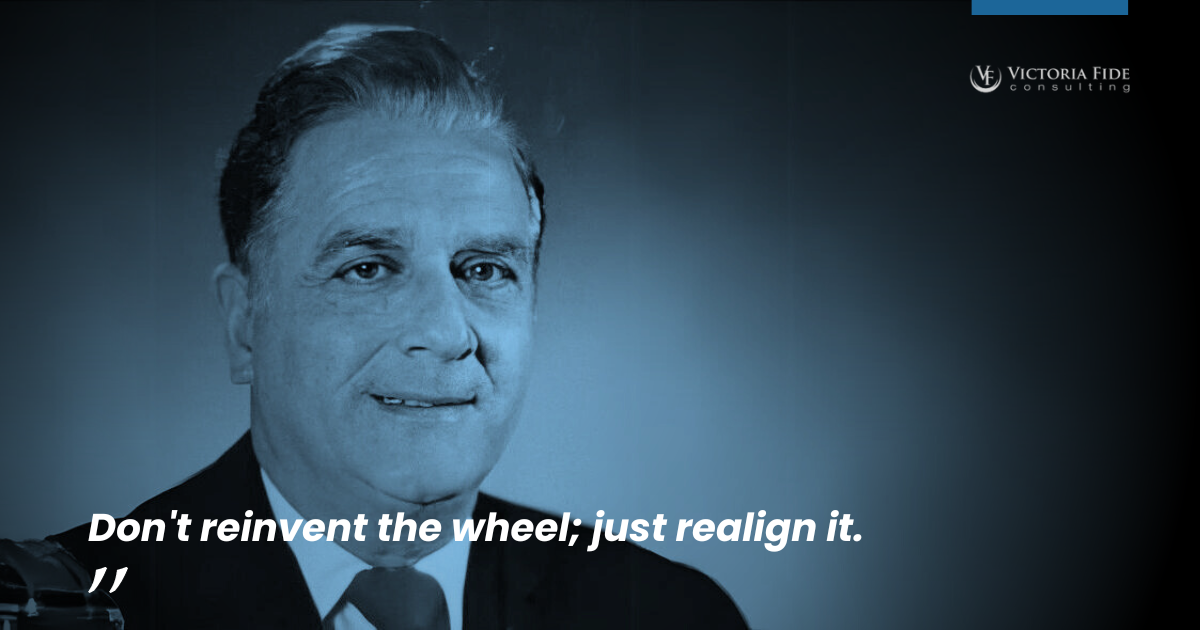
Realigning Over Reinventing: Applying D’Angelo’s Wisdom to Digital Transformation
The Sage Wisdom series is produced by Victoria Fide Marketing with input and oversight from our leadership team and industry SMEs.
Anthony J. D’Angelo is a distinguished writer, speaker, and entrepreneur renowned for his impactful works on personal development, leadership, and entrepreneurship. In 1995, D’Angelo founded The Collegiate Empowerment Company, which offers tailored educational programs and coaching services designed for both college students and professionals. Among his notable literary contributions are titles like “Inspiration for Resident Assistants,” “The College Blue Book,” and “The Student Success Manifesto.” In his commitment to guiding individuals toward excellence, Anthony J. D’Angelo exemplifies the essence of inspirational leadership and transformative growth.
D’Angelo’s wisdom is encapsulated in one of his many quotes, “Don’t reinvent the wheel; just realign it.” These few words hold great wisdom, especially when applied to the concept of design principles in digital transformation (DX). Despite the abundance of customizable solutions and unique business models that require flexibility, it is dangerous to rely on building solutions without understanding certain design principles. D’Angelo’s words urge business leaders to save time and money by utilizing design principles from an existing body of knowledge and realigning them for their specific needs.
Understanding the pivotal role of design principles in shaping the solution design process is a crucial step toward achieving a successful digital transformation. In this article, we will explore the strategic benefits of design principles and how to realign them to best fit your specific requirements. We will examine a real-world scenario of an organization who failed to adhere to design principles and suffered the consequences, and study how it could have been avoided. By understanding D’Angelo’s wisdom of realigning over reinventing, you can cut costs while finding a solution that meets your business objectives, satisfies best practices, and sets you apart from the competition, positioning yourself for DX success.
Understanding Design Principles
Design principles are a set of guiding values that shape the solution design process. These principles are crucial not only for ensuring that the result is functional and efficient, but also for guaranteeing cost-effectiveness, flexibility, and scalability. They help solve common problems and can also help avoid common pitfalls. These proven principles guide businesses toward solutions that truly meet their needs and stand the test of time while setting the stage for agility and future improvements.
Design principles are often found within a body of knowledge – an open-source community where professionals gather and document best practices and design principles. Examples include APICS OMBOK (Operations Management Body of Knowledge), GAAP (Generally Accepted Accounting Principles), and other industry-specific repositories. These platforms provide a wealth of information on tried and tested principles that have achieved success across a variety of sectors. By understanding the design principles within a body of knowledge, you can take them and realign them to your specific situation, giving you the best solution to fit your needs.

Free PDF Download
In the rapidly changing digital landscape, more and more companies are desperately trying to keep up with the competition. Download “The 10 Biggest Mistakes Businesses Make in Digital Transformation” for free today to learn how to use DX to radically transform your business and gain an edge over your competitors.
Let’s take inventory management as an example. When designing a solution for inventory management, there are certain design principles to keep in mind, one of which is demand forecasting. Purchasing, storing, and managing inventory are all necessary activities that incur high costs for businesses. Demand forecasting is a principle of inventory management that allows businesses to accurately predict not only the amount of inventory they will sell, but also the type of inventory.
The principle behind demand forecasting can be boiled down to: have what you need when you need it. How you use that principle for your organization may look different from other businesses, but it will involve specific best practices such as ensuring safety stock levels and setting min-max levels for each item in your inventory to reduce costly overstocks and manage warehouse space.
By aligning DX goals with robust, proven design principles, organizations can create seamless, intuitive experiences that not only meet but exceed customer expectations, thereby driving competitive advantage and business growth.
Realign – Don’t Reinvent
Anthony D’Angelo’s famous quote, ‘Don’t reinvent the wheel; just realign it,’ emphasizes the value of utilizing existing resources and knowledge, rather than starting from scratch. It suggests that we should focus on adjusting or ‘realigning’ proven design principles and best practices to meet new challenges or goals, as opposed to attempting to reinvent entirely new solutions. With a little bit of research, organizations may find that there is already a solution that fits their needs without needing to invest thousands of dollars into extensive customization.
This approach is not only efficient, making use of tried-and-true methods, but it also embodies wisdom, acknowledging the lessons learned from past experiences. In DX, this translates to leveraging established design principles, technological innovations, and business models, and realigning them to better serve the evolving needs of customers and the market. By doing so, businesses can accelerate their digital transformation journeys while minimizing risks and maximizing returns.
The Impact of Design Choices: Lessons Learned from Manufacturing
Design principles play a pivotal role in solving common problems and averting potential hurdles in DX projects. Let’s unravel this through a real-world example in the manufacturing realm.
In production and inventory, a fully indented bill of material (BOM) can provide various perspectives such as exploded, single level, or modular views. It can be analyzed through different lenses such as engineering, sales, manufacturing, or service BOM. The underlying design principle, however, remains consistent – it is necessary to store the BOM as a fully indented bill of material down to the lowest level that was purchased.
Consider an ambitious project undertaken by a manufacturing organization in the mid-’90s. The goal was to streamline their process by eliminating the need for detailed, piece-part drawings. Additionally, they wanted to eliminate the need for a Computer-Aided Manufacturing (CAM) system and send the drawings directly from CAD to CNC mills, enhancing overall efficiency.
However, during the project, the company chose to specify the raw material of a part as an attribute of that part, instead of using a fully indented bill of material. For instance, if a part was made from 1”x4” cold rolled steel bar stock, it was simply marked with an attribute specifying its material.
This decision, though seemingly logical, led to complications. When the company later attempted to implement Material Requirements Planning (MRP), they faced difficulties in quantifying the required raw materials due to the lack of a fully indented bill of material. Consequently, they had to rely on estimations for purchases, preventing them from fully harnessing the MRP system’s capabilities.

Transformation is not easy, but it doesn’t have to be impossible. Take control of your project’s success today and schedule a free 30-minute consultation to find out how Victoria Fide can equip you for transformational success.
This seemingly innocuous decision led to a domino effect of increasingly time-consuming practices, imprecise material purchases, and inefficient processes to work around the limitations with which they had saddled themselves. If they had simply adhered to the design principle of storing their bill of material fully indented, they would have been able to take full advantage of their MRP system, and they would have been able to easily adapt their processes over the years as their organization and the industry evolved.
Mastering the Art of Realignment: The Path to Innovation
In conclusion, embracing the wisdom of Anthony D’Angelo’s advice, ‘Don’t reinvent the wheel; just realign it,’ becomes crucial in the journey of digital transformation. Organizations should not set aside proven design principles and best practices, but instead adapt them to meet their needs. This requires organizations to comprehend the core design principles that drive best practices and become adept at realigning these principles to suit their unique needs, capabilities, and business processes. This balanced approach ensures that they are not merely following trends or adopting practices that may not resonate with their specific situation. Instead, it offers a pathway to leverage existing knowledge and resources effectively, leading to cost reduction, enhanced flexibility, interoperability, and scalability.
Remember, your organization’s unique ‘special sauce’ is what sets it apart in a competitive market. The realignment of proven design principles to your distinct requirements ensures that you continue to serve your users and customers in the best possible way while standing out from the crowd. As we navigate the ever-evolving business landscape, let us strive to master the art of realignment, fueling our digital transformation journeys with wisdom, efficiency, and a keen eye for innovation.

Subscribe to our weekly LinkedIn Digital Transformation Success newsletter and get notified of each new edition.
